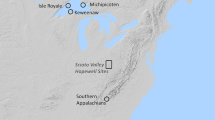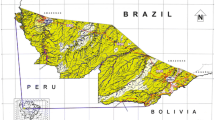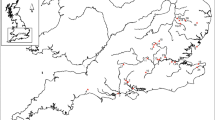Abstract
This chapter examines results from the application of LA-ICP-MS to the identification of sources of obsidian artifacts from the Western Pacific. More than 700 analyses of obsidian samples collected at the Australian National University over the past years provide an accurate geochemical dataset for major obsidian source regions in the Western Pacific unambiguously discriminating sources and sub-sources. This dataset is employed to analyze social interaction in the 3000-year timeframe of human occupation of the western Pacific as reflected by variations in lithic raw material sources. Albeit not non-destructive, the minimal sample size necessary, and the precision and accuracy of analysis for a wide range of major, minor, trace and rare earth elements enables LA-ICP-MS to not only geochemically fingerprint archaeological artifacts to known source locations, but also to provide information about general geological contexts from which these objects derived. These additional data have been successfully employed in the past to identify locations of high probability for undetected obsidian outcrops.
Access this chapter
Tax calculation will be finalised at checkout
Purchases are for personal use only
Similar content being viewed by others
Notes
- 1.
The numerous obsidian sources in New Zealand are excluded from this analysis, because of the late colonisation of the island and the limited transportation of New Zealand obsidian into the central and western Pacific.
- 2.
Large-ion lithophile elements (LILEs) and high-field-strength elements (HFSEs) are two categories of elements in geochemistry. Both groups have the tendency to stay in liquid phase during fractionation process in the melt. They are classified by the ratio of their electrostatic potential to their ionic radius, which is informative about the origin of rocks, e.g. abundance of LILEs would indicate continental crusts (Albarède 2003:18).
References
Acquafredda P, Paglionico A (2004) SEM-EDS microanalysis of microphenocrysts of Mediterranean obsidians: a preliminary approach to source discrimination. Eur J Miner 16:419–429
Albarède F (2003) Geochemistry: an introduction. Cambridge University Press, Cambridge
Ambrose WR (1976) Obsidian and its prehistoric distribution in Melanesia. In: Barnard N (ed) Ancient Chinese bronzes and South East Asian metal and other archaeological artifacts. National Gallery of Victoria, Melbourne, pp 351–378
Ambrose WR, Duerden P (1982) PIXE analysis in the distribution and chronology of obsidian use in the Admiralty Islands. In: Ambrose WR, Duerden P (eds) Archaeometry: an Australasian perspective. Occasional papers in prehistory. RSPAS and ANU, Canberra, p 83–89
Ambrose WR, Johnson RW (1986) Unea: an Obsidian non-source in Papua New Guinea. J Polynesian Soc 95:491–497
Ambrose WR, Bird JR, Duerden P (1981a) The impermanence of obsidian sources in Melanesia. In: Leach BF, Davidson J (eds) Archaeological studies of Pacific stone resources. British Archaeological Reports: International Series, Oxford, pp 1–19
Ambrose WR, Duerden P, Bird JR (1981b) An archaeological Application of PIXE-PIGME analysis to Admiralty Islands obsidians. Nucl Instrum Method 191:397–402
Ambrose WR, Allen C, O’Connor S, Spriggs M, Oliveira NV, Reepmeyer C (2009) Possible obsidian sources for artefacts from Timor: narrowing the options using chemical data. J Archaeol Sci 36:607–615
Araho N, Torrence R, White JP (2002) Valuable and useful: mid-Holocene stemmed obsidian artefacts from West New Britain, Papua New Guinea. Proc Prehist Soc 68:61–81
Barsdell M, Smith IEM, Spoerli KB (1982) The origin of reversed geochemical zoning in the Northern New Hebrides volcanic arc. Contrib Mineral Petr 81:148–155
Baxter MJ, Cool HEM, Jackson CM (2006) Comparing glass compositional analyses. Archaeometry 48:399–414
Bellwood P, Koon P (1989) Lapita colonists leave boats unburned! The questions of Lapita links with Island South East Asia. Antiquity 63:613–622
Bird JR (1996) Pacific Obsidian Studies, Unpublished Report. ANSTO, Sydney
Bird JR, Ambrose WR, Russell LH, Scott MD (1981a) The characterisation of Melanesian obsidian sources and artefacts using the proton induced gamma ray emission (PIGME) technique, AAEC/E510. Australian Atomic Energy Commission, Lucas Heights (NSW)
Bird JR, Duerden P, Ambrose WR, Leach BF (1981b) Pacific obsidian catalogue. In: Leach BF (ed) Lithic resources of the Pacific Region, vol 104. British Archaeological Reports International Series (BAR), Oxford, pp 31–43
Bird JR, Torrence R, Summerhayes GR, Bailey G (1997) New Britain obsidian sources. Archaeol Ocean 32:61–67
Chayes F (1964) A petrographic distinction between Cenozoic volcanics in and around the open oceans. J Geophys Res 69:1573–1588
Deer WA, Howie RA, Zussman J (1992) An introduction to the rock-forming minerals, 2nd edn. Longman Scientific & Technical/Wiley, New York, NY
Duerden P, Clayton E, Bird JR, Ambrose WR, Leach BF (1987) Obsidian composition catalogue. In: Ambrose WR, Mummery JMJ (eds) Archaeometry: further Australasian studies. Occasional papers in prehistory. RSPAS and ANU, Canberra, pp 232–238
Eggins SM, Kinsley LPJ, Shelley JMG (1998) Deposition and element fractionation processes during atmospheric pressure laser sampling for analysis by ICP-MS. Appl Surf Sci 127:278–286
Falkner KK, Klinkhammer GP, Ungerer CA, Christie DM (1995) Inductively coupled plasma mass spectrometry in geochemistry. Annu Rev Earth Pl Sci 23:409–449
Fullagar R (1992) Lithically Lapita. Functional analysis of flaked stone assemblages from West New Britain Province, Papua New Guinea. In: Galipaud J-C (ed) Poterie Lapita et Peuplement. ORSTOM, Noumea, pp 135–143
Fullagar R (1993) Flaked stone tools and plant food production: a preliminary report on obsidian tools from Talasea, West New Britain, PNG. In: Anderson PC, Beyries S, Otte M, Plisson H (eds) Traces et Fonction: Les gestes retrouvés. ERAUL, Liège, pp 331–337
Fullagar R, Ambrose WR, Bird JR, Specht J, Torrence R (1989) Stocktaking the rocks: obsidian sources in West New Britain, Papua New Guinea. Proceedings of the AINSE conference on nuclear techniques of analysis, p 187–189
Fullagar R, Ivuyo B, Specht J, Summerhayes GR (1991) Obsidian sources at Mopir, West New Britain Province, Papua New Guinea. Archaeol Ocean 26:110–114
Goffer Z (2007) Archaeological chemistry. Wiley, Hoboken, NJ
Goldstein JI, Newbury DE, Echlin P, Joy DC, Fiori C, Lifshin E (1992) Scanning electron microscopy and X-ray microanalysis: a text for biologists, materials scientists, and geologists, 2nd edn. Plenum Press, New York, NY
Golitko M, Meierhoff J, Terrell JE (2010) Chemical characterization of sources of obsidian from the Sepik coast (PNG). Archaeol Ocean 45:120–129
Gratuze B, Blet-Lemarquand M, Barrandon J-N (2001) Mass spectrometry with laser sampling: a new tool to characterize archaeological materials. J Radioanal Nucl Chem 247:645–656
Green RC (1987) Obsidian results from the Lapita sites of the Reef/Santa Cruz Islands. In: Ambrose WR, Mummery JMJ (eds) Archaeometry: further Australasian studies. Occasional papers in prehistory. RSPAS and ANU, Canberra, pp 239–249
Green RC, Bird JR (1989) Fergusson Island obsidian from the D’Entrecasteaux group in a Lapita site of the Reef Santa Cruz group. NZ J Archaeol 11:87–99
Juggins S (2005) C2 data analysis, 1.4.2 edn. University of Newcastle, Newcastle
Kayani PI, McDonnell G (1996) An assessment of back-scattered electron petrography as a method for distinguishing Mediterranean obsidians. Archaeometry 38:43–58
Kirch PV (1988) Long-distance exchange and Island colonization: the Lapita case. Nor Archaeol Rev 21:103–117
Kononenko NA (2012) Middle and late Holocene skin-working tools in Melanesia: tattooing and scarification? Archaeol Ocean 47:14–28
Kononenko NA, Bedford S, Reepmeyer C (2010) Functional analysis of late Holocene flaked and pebble stone artefacts from Vanuatu, Southwest Pacific. Archaeol Ocean 45:13–20
Leach BF, Davidson J (1981) Archaeological studies of Pacific stone resources. British Archaeological Reports: International Series, Oxford
Leach BF, Manly B (1982) Minimum Mahalanobis distance functions and lithic source characterisation by multi-element analysis. NZ J Archaeol 4:77–109
Lee YI, Sneddon J (1994) Direct and rapid determination of potassium in standard solid glasses by excimer laser ablation plasma atomic emission spectrometry. Analyst 119:1441–1443
Longerich HP, Jackson SE, Günther D (1996) Laser ablation inductively coupled plasma mass spectrometric transient signal data acquisition and analyte concentration calculation. J Anal Atom Spectrom 11:899–904
MacIntyre M (1983) Changing paths: a historical ethnology of the traders of Tubetube. Research School of Pacific Studies, Australian National University, Canberra
Pollard M, Batt C, Stern B, Young SMM (2007) Analytical chemistry in archaeology. Manuals in Archaeology. Cambridge University Press, Cambridge
Raos AM, Crawford AJ (2004) Basalts from the Efate Island Group, central section of the Vanuatu arc, SW Pacific: geochemistry and petrogenesis. J Volcanol Geotherm Res 134:35–56
Reed SJB (2005) Electron microprobe analysis and scanning electron microscopy in geology, 2nd edn. Cambridge University Press, Cambridge
Reepmeyer C (2008) Characterising volcanic glass sources in the Banks Islands, Vanuatu. Archaeol Ocean 43:120–127
Reepmeyer C (2009) Obsidian sources and distribution systems emanating from Gaua and Vanua Lava on the Banks Islands of Vanuatu. Ph.D Dissertation, Australian National University
Reepmeyer C, Clark GR (2010) Post-colonization interaction between Vanuatu and Fiji reconsidered: the reanalysis of obsidian from Lakeba Island, Fiji. Archaeometry 52:1–18
Reepmeyer C, Clark GR, Sheppard PJ (2012) Obsidian source use in Tongan prehistory: new results and implications. J Island Coastal Archaeol 7:255–271
Rothe P (2005) Gesteine: Entstehung, Zerstörung, Umbildung, 2nd edn. Primus Verlag, Darmstadt
Sheppard PJ (1993) Lapita lithics: trade/exchange and technology. A view from the Reefs/Santa Cruz. Archaeol Ocean 28:121–137
Sheppard PJ, Hancock RGV, Pavlish LA, Parker R (1989) Samoan volcanic glass. Archaeol Ocean 24:70–74
Smith IEM (1974) Obsidian sources in Papua-New Guinea. Archaeol Phys Anthropol Ocean 9:18–25
Smith IEM, Price RC (2006) The Tonga-Kermadec arc and Havre-Lau back-arc system: their role in the development of tectonisc and magmatic models for the western Pacific. J Volcanol Geotherm Res 156:315–331
Smith IEM, Ward GK, Ambrose WR (1977) Geographic distribution and the characterization of volcanic glasses in Oceania. Archaeol Ocean 12:173–201
Smith IEM, Steward RB, Price RC (2003) The petrology of a large intra-oceanic silicic eruption: the Sandy Bay Tephra, Kermadec Arc, Southwest Pacific. J Volcanol Geotherm Res 124:173–194
Specht J (2002) Obsidian, colonising and exchange. In: Bedford S, Sand C, Burley D (eds) Fifty years in the field: essays in honour and celebration of Richard Shutler Jr’s Archaeological career. New Zealand Archaeological Association Monograph, Auckland, pp 37–49
Specht J, Koettig M (1981) An obsidian flaking area near Talasea, West New Britain, Papua New Guinea. Archaeol Ocean 16:168–172
SPSS (2006) SPSS for Windows, 16.0 edition. SPSS, Chicago, IL
Summerhayes GR (2004) The nature of prehistoric obsidian importation to Anir and the development of a 3,000 year old regional picture of obsidian exchange within the Bismarck Archipelago, Papua New Guinea. Records of the Australian Museum 29(Suppl):145–156
Summerhayes GR (2009) Obsidian network patterns in Melanesia – sources, characterisation and distribution. Bull Indo Pac Pre Hist Assoc 29:109–124
Summerhayes GR, Allen J (1993) The transport of Mopir obsidian to late Pleistocene New Ireland. Archaeol Ocean 28:144–148
Summerhayes GR, Bird JR, Fullagar R, Gosden C, Specht J, Torrence R (1998) Application of PIXE-PIGME to archaeological analysis of changing patterns of obsidian use in West New Britain, Papua New Guinea. In: Shackley MS (ed) Archaeological obsidian studies: method and theory. Plenum Press, New York, NY, pp 129–158
Sun S-S, McDonough WF (1989) Chemical and isotopic systematics of oceanic basalts: implications for mantle composition and processes. In: Saunders AD, Norry MJ (eds) Magmatism in the ocean basins, geological society special publications. Blackwell, Oxford, pp 313–345
Torrence R (2004) Pre-Lapita valuables in Island Melanesia. Records of the Australian Museum 29(Suppl):163–172
Torrence R (2005) Valued stone – how so? In: Macfarlane I, Mountain M-J, Paton R (eds) Many exchanges: archaeology, history, community and the work of Isabel McBryde. Aboriginal History Monograph, Canberra, pp 357–372
Torrence R (2011) Finding the right question: learning from stone tools on the Willaumez Penisula, Papua New Guinea. Archaeol Ocean 46:29–41
Torrence R, Specht J, Fullagar R, Bird JR (1992) From pleistocene to present: obsidian sources in West New Britain, Papua New Guinea. Records of the Australian Museum 15(Suppl):83–98
Torrence R, Specht J, Fullagar R, Summerhayes GR (1996) Which obsidian is worth it? In: Davidson J, Irwin G, Leach BF, Pawley A, Brown D (eds) Oceanic culture history: essays in honour of Roger Green. New Zealand Journal of Archaeology Special Publication, Dunedin, pp 211–224
Tykot RH (2004) Scientific methods and applications to archaeological provenance studies. In: Martini M, Milazzo M, Piacentini M (eds) Proceedings of the International School of Physics “Enrico Fermi” course CLIV. IOS Press, Amsterdam, pp 407–432
Vinx R (2005) Gesteinsbestimmung im Gelände. Spektrum Akademischer Verlag, Munich
Wall T (1976) Use of the research reactor Moata and associated facilities for the source identification of obsidian artefacts. In: Barnard N (ed) Ancient Chinese bronzes and South East Asian metal and other archaeological artifacts. National Gallery of Victoria, Melbourne, pp 337–350
Ward G (1979) Prehistoric settlement and economy in a tropical small island environment: the Banks Islands, Insular Melanesia. Australian National University, Canberra
Weisler MI (1998) Hard evidence for prehistoric interaction in Polynesia. Curr Anthropol 39:521–532
White JP, Jacobsen H, Kewibu V, Doelman T (2006) Obsidian traffic in the Southeast Papuan Islands. J Island Coastal Archaeol 1:101–108
Wilson L, Pollard A (2001) The provenance hypothesis. In: Brothwell D, Pollard A (eds) Handbook of archaeological sciences. Wiley, Chichester, pp 507–517
Author information
Authors and Affiliations
Corresponding author
Editor information
Editors and Affiliations
Rights and permissions
Copyright information
© 2016 Springer-Verlag Berlin Heidelberg
About this chapter
Cite this chapter
Reepmeyer, C., Ambrose, W., Clark, G. (2016). Contributions of LA-ICP-MS to Obsidian Sourcing in the Pacific. In: Dussubieux, L., Golitko, M., Gratuze, B. (eds) Recent Advances in Laser Ablation ICP-MS for Archaeology. Natural Science in Archaeology. Springer, Berlin, Heidelberg. https://doi.org/10.1007/978-3-662-49894-1_10
Download citation
DOI: https://doi.org/10.1007/978-3-662-49894-1_10
Published:
Publisher Name: Springer, Berlin, Heidelberg
Print ISBN: 978-3-662-49892-7
Online ISBN: 978-3-662-49894-1
eBook Packages: Social SciencesSocial Sciences (R0)




